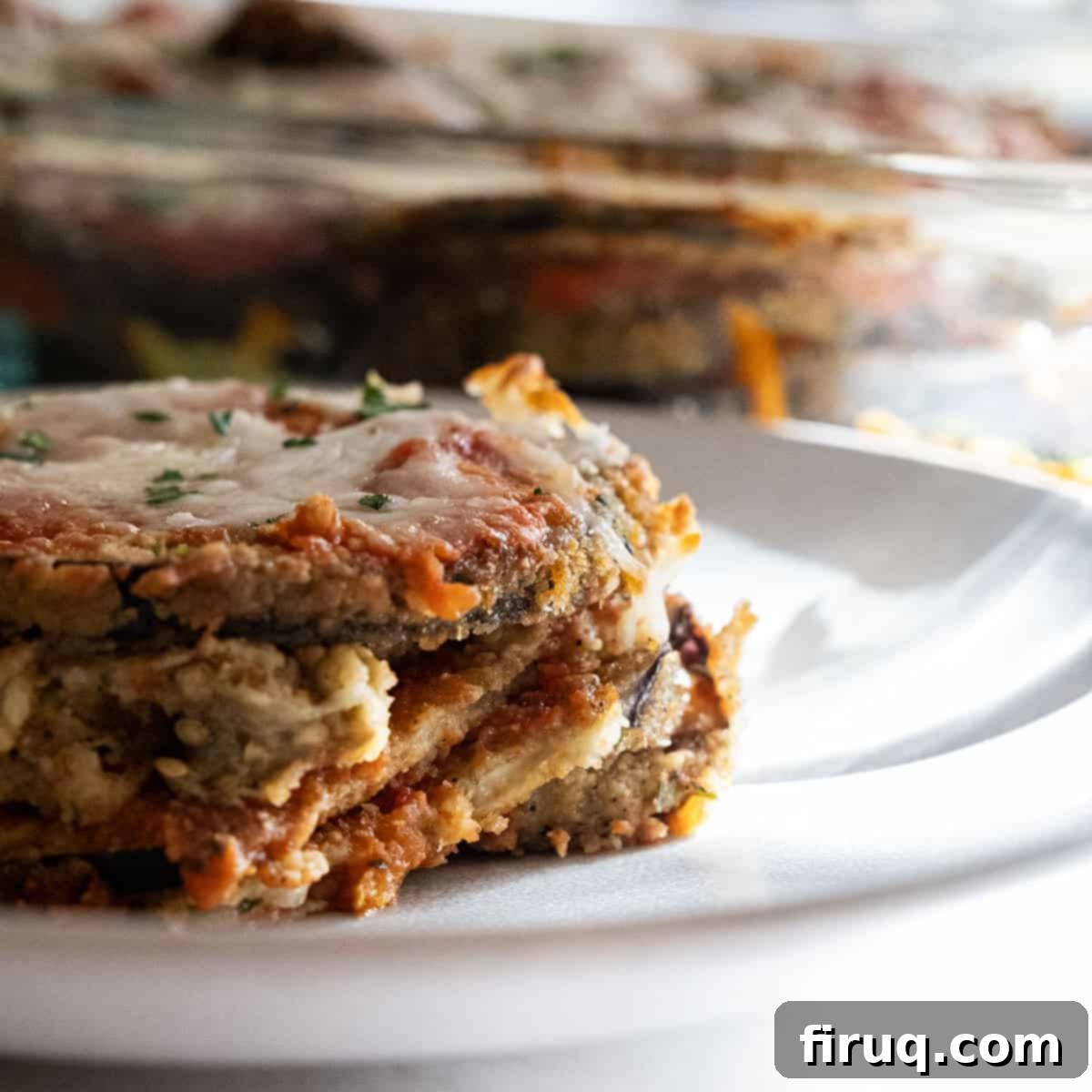Ultimate Homemade Eggplant Parmigiana: A Recipe That Beats Olive Garden’s Every Time
There’s an undeniable magic to homemade Italian cooking, especially when it comes to classics like Eggplant Parmigiana. Anyone who has taken the time to craft this dish from scratch will tell you one thing: it’s vastly superior to any restaurant version, including the popular Olive Garden Eggplant Parmigiana. The secret lies not in a hidden ingredient or a complex technique, but in two simple factors: the effort you invest and the quality of the ingredients you choose. When you prepare it yourself, with fresh, high-quality components, the resulting flavor is exponentially more delicious – a truly authentic taste that mass-produced versions simply cannot replicate.
While this baked eggplant masterpiece requires a little love and patience, the reward is a deeply satisfying and flavorful meal. If you’re craving Italian flavors but need something a bit quicker, consider trying our Pasta alla Norma (A Sicilian Dish) for a delicious alternative.
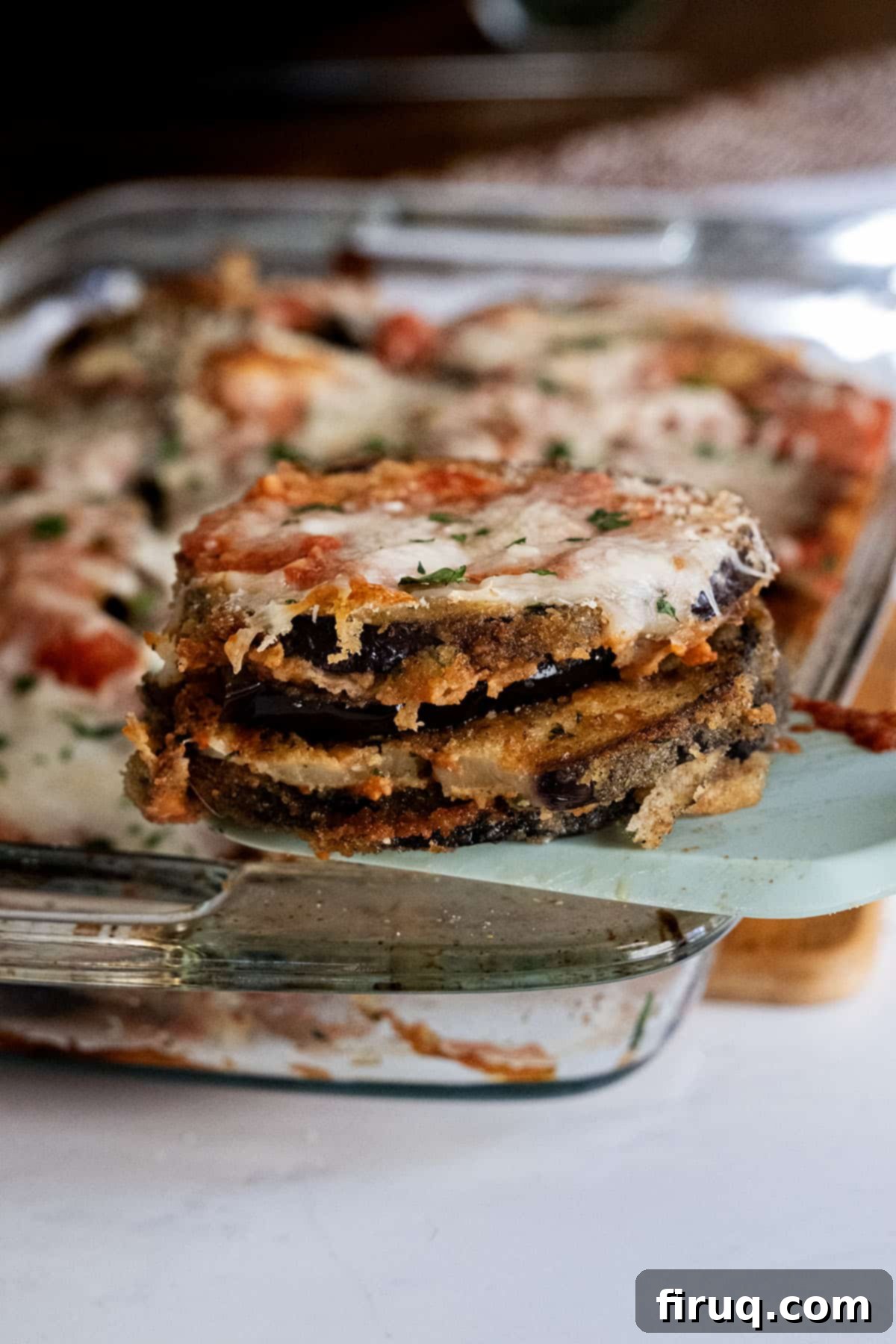
This homemade Eggplant Parmigiana is a guaranteed crowd-pleaser, perfect for family dinners or entertaining guests. If you adore this Italian classic, you might also want to explore other hearty Italian main courses that pair beautifully or stand alone. Consider serving up a rich Restaurant-Style Chicken Scarpariello, a savory Restaurant-Style Chicken Saltimbocca, or a rustic Chicken Pizzaiola to complete your Italian feast.
[feast_advanced_jump_to]
Ingredient Spotlight: Tips for Perfect Eggplant Parmigiana
Creating truly exceptional Eggplant Parmigiana begins with understanding your ingredients. Here’s a breakdown of key components and how to ensure they contribute to the best possible flavor and texture.
- Sauce. The sauce is the heart of any good Italian dish, and Eggplant Parmigiana is no exception. Below, I’ve included instructions for my quick, flavorful sauce, which is a simplified version of my beloved Sunday sauce. While traditional Sunday sauce simmers for hours to develop deep flavors, this version achieves a delicious richness in just 30 minutes, making it perfect for this recipe. Making your own sauce from scratch is always the best way to go, as it allows you to control the freshness and depth of flavor. However, if time is truly of the essence, a high-quality jarred marinara sauce can be used as a substitute. Just be sure to choose one with minimal added sugars and a robust tomato flavor. My grandmother would certainly prefer I make my own, so I always strive for that homemade touch!
- Eggplant. Achieving perfectly cooked eggplant is crucial for a non-soggy, flavorful dish. When frying eggplant, a key step is to remove as much excess moisture as possible. Lay the eggplant slices on a flat surface or a cooling rack, sprinkle both sides generously with salt, and let them sit for about 20-30 minutes. This process draws out moisture, preventing the eggplant from becoming waterlogged during frying and ensuring a crispier texture. After salting, gently pat the slices completely dry with paper towels to remove the moisture and any excess salt.
- Can you skip the salting step? Yes, you can. In the past, I’ve skipped this step many times when I’m short on time. The eggplant will still cook through and be enjoyable. However, omitting this step might result in a slightly less crispy fry and less evenly seasoned eggplant. For the absolute best results and a truly superior texture, I highly recommend taking the extra few minutes for this simple but impactful preparation.
- Breadcrumb Mixture. This isn’t just about coating; it’s about adding a layer of seasoned crunch and flavor. It is imperative that you season your breadcrumbs. This is not an optional step! Without the addition of salt, garlic powder, parsley, and parmesan, your eggplant coating will taste incredibly bland, failing to contribute to the rich, savory profile of the final dish. Don’t underestimate the power of a well-seasoned breading!
- Olive Oil. The choice of frying oil significantly impacts the taste and texture of your fried eggplant. Using the right oil to fry your eggplant in is paramount for achieving that golden-brown, crispy exterior without a greasy feel. For this dish, we highly recommend extra virgin olive oil for its high smoke point and distinct flavor that complements Italian cuisine beautifully. To delve deeper into the science and benefits of frying with different oils, we encourage you to read our detailed article about frying with the right oils to learn about why extra virgin olive oil is the best option when it comes to frying your eggplant.
- Egg. Eggs serve as the binding agent for the breadcrumbs, helping them adhere to the eggplant slices. If you’re looking for alternatives, there are a few possible substitutions for eggs that can work effectively, such as heavy cream, milk, or even a plant-based milk alternative mixed with a little flour. For a comprehensive discussion and analysis of various egg substitutes in breading applications, check out our guide on No Egg Chicken Cutlets.
*Please see the full recipe card below for precise measurements and detailed ingredient information.
Step-by-Step Directions: Crafting Your Perfect Eggplant Parmigiana
Follow these detailed steps to create a truly irresistible homemade Eggplant Parmigiana. Each stage is designed to build flavor and achieve the ideal texture, from the rich tomato sauce to the perfectly golden eggplant layers.
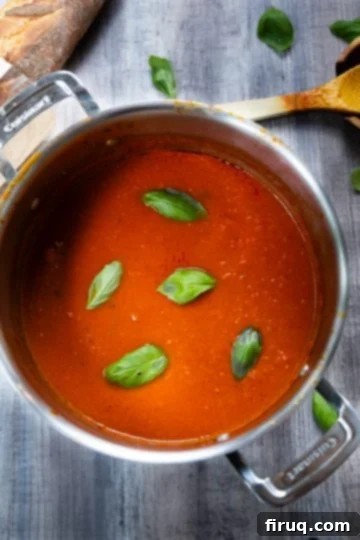
Step 1: Prepare Your Rich Tomato Sauce. Begin by placing a medium pot on your stovetop and setting the heat to medium. Add 1 tablespoon of olive oil, allowing it to heat gently before adding the minced garlic. Sauté the garlic for 1-2 minutes, or until it becomes wonderfully fragrant and slightly golden, being careful not to burn it. Pour in the crushed tomatoes and bring the mixture to a gentle simmer. Stir in the fresh basil leaves and a teaspoon of salt. Allow your sauce to simmer for at least 30 minutes, stirring occasionally, to let the flavors meld and deepen. This quick simmer creates a vibrant and fresh sauce that forms the perfect base for your parmigiana.
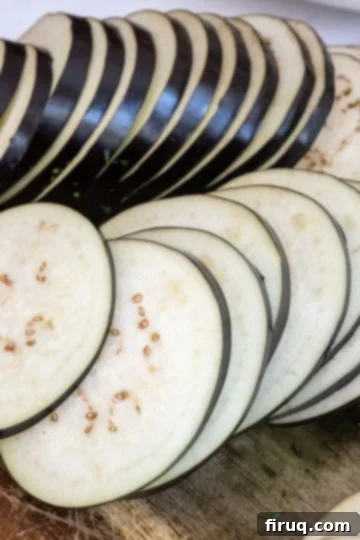
Step 2: Slice the Eggplant. Carefully slice the eggplants into uniform ¼-inch circular slices, as depicted in the image. You might be surprised, but there is absolutely no need to remove the skin. Modern eggplant varieties have been specifically bred to reduce bitterness, meaning the skin is no longer tough or unpalatable after cooking. In fact, leaving the skin on adds a beautiful color, a touch more fiber, and helps the eggplant maintain its shape. This small time-saving tip doesn’t compromise on flavor or texture, making your prep even easier.
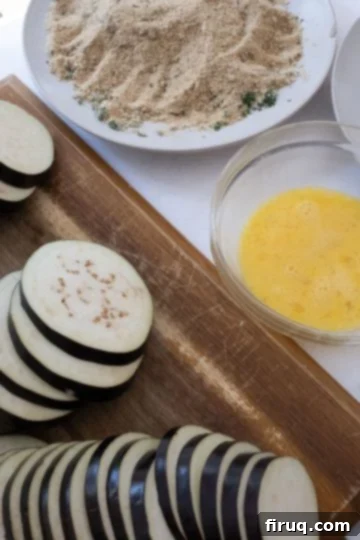
Step 3: Egg and Breading Station Setup. Prepare your dredging station efficiently. In a shallow bowl, whisk the eggs thoroughly until they are light and frothy. On a separate, flat plate or a wide, shallow dish, combine the breadcrumbs, kosher salt, garlic powder, fresh parsley, and grated parmesan cheese. Mix these ingredients well to ensure the seasonings are evenly distributed throughout the breadcrumbs. Take each eggplant slice, dip it fully into the whisked egg, allowing any excess to drip off, then immediately transfer it to the seasoned breadcrumb mixture. Press gently to ensure a thorough and even coating on both sides.
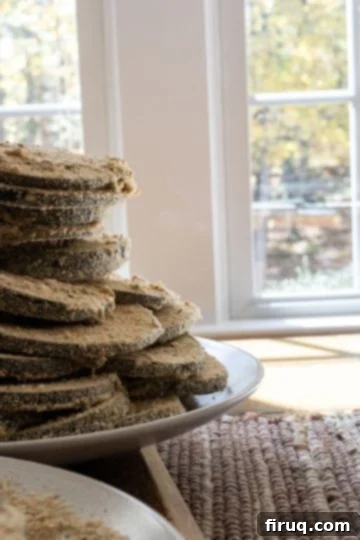
Step 4: Bread All Eggplant Slices. After coating each eggplant slice, transfer it to a clean plate or baking sheet. Arrange them in a single layer if possible, or stack them carefully with parchment paper in between if space is limited. Continue this process of dipping in egg and dredging in breadcrumbs until all of your eggplant slices are thoroughly coated and ready for frying. This organized approach ensures you have all your eggplant prepped and ready for the next step, streamlining the cooking process.
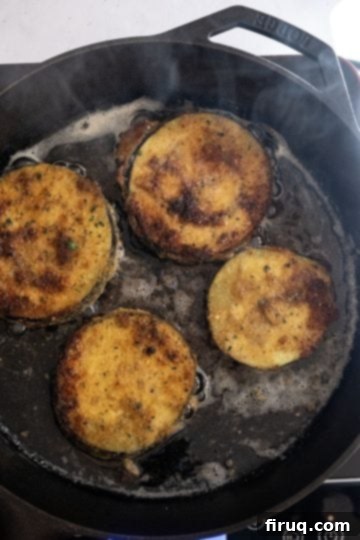
Step 5: Fry the Eggplant to Golden Perfection. Pour about ½ an inch of good quality olive oil into a large frying pan and place it on the stovetop over medium-high heat. Allow the oil to heat sufficiently; you can test it by flicking a tiny bit of breadcrumb into the oil – it should sizzle immediately. Once the olive oil is hot and shimmering, carefully place your breaded eggplant slices into the oil in batches. Ensure not to overcrowd the pan, as this can lower the oil temperature and lead to soggy eggplant. Fry each side of the eggplant for approximately 2 minutes, or until it achieves a beautiful golden-brown color and a crispy exterior. Remove the fried eggplant slices with tongs and place them on a cooling rack lined with paper towels to drain any excess oil. While still warm, sprinkle each side lightly with a small amount of kosher salt for enhanced flavor.
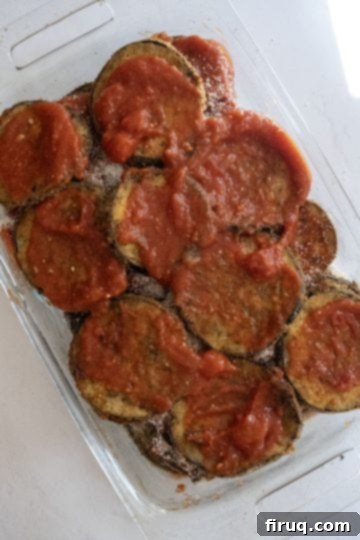
Step 6: Begin Layering the Parmigiana. Preheat your oven to 375℉ (190°C) to ensure it’s ready for baking. To assemble your masterpiece, start by spreading a generous couple of spoonfuls of your delicious homemade tomato sauce across the bottom of your baking pan. This not only adds flavor but also prevents the first layer of eggplant from sticking. Arrange a single layer of your golden-fried eggplant slices over the sauce. Once the eggplant layer is complete, spoon another ample amount of sauce over it, ensuring each piece is well-covered. This initial layering sets the foundation for a moist and flavorful parmigiana.
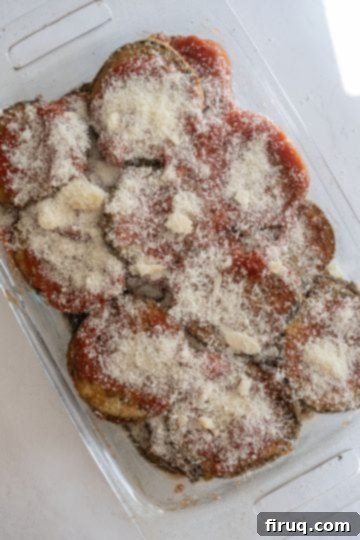
Step 7: Continue Layering with Parmesan. After adding the sauce to your first eggplant layer, it’s time for the cheese. Generously sprinkle parmesan cheese evenly over the sauced eggplant. This sharp, salty cheese adds a crucial depth of flavor and helps create that irresistible cheesy pull. Then, add another layer of fried eggplant slices, followed by more sauce and parmesan. Continue this layering process, alternating eggplant, sauce, and parmesan, until you reach the top of your baking pan. Be sure to press down gently between layers to ensure a compact, cohesive parmigiana.
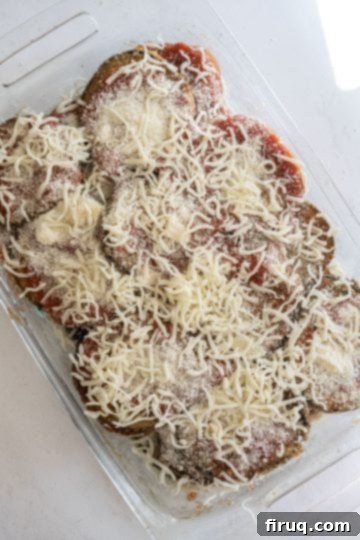
Step 8: Final Cheese Layer and Baking. Once you’ve reached the top of your baking pan with layers of eggplant, sauce, and parmesan, finish by adding a generous layer of shredded mozzarella cheese. This will melt beautifully, creating a golden, bubbly crust that is simply irresistible. Place the assembled pan into your preheated oven and bake for approximately 20-25 minutes. The goal is for the cheese to be fully melted and bubbly, and the edges of the parmigiana to be slightly golden. Once baked to perfection, carefully remove the pan from the oven. Allow it to rest for 5-10 minutes before serving, as this helps the layers set and makes for easier, cleaner slices. Enjoy your magnificent homemade Eggplant Parmigiana!
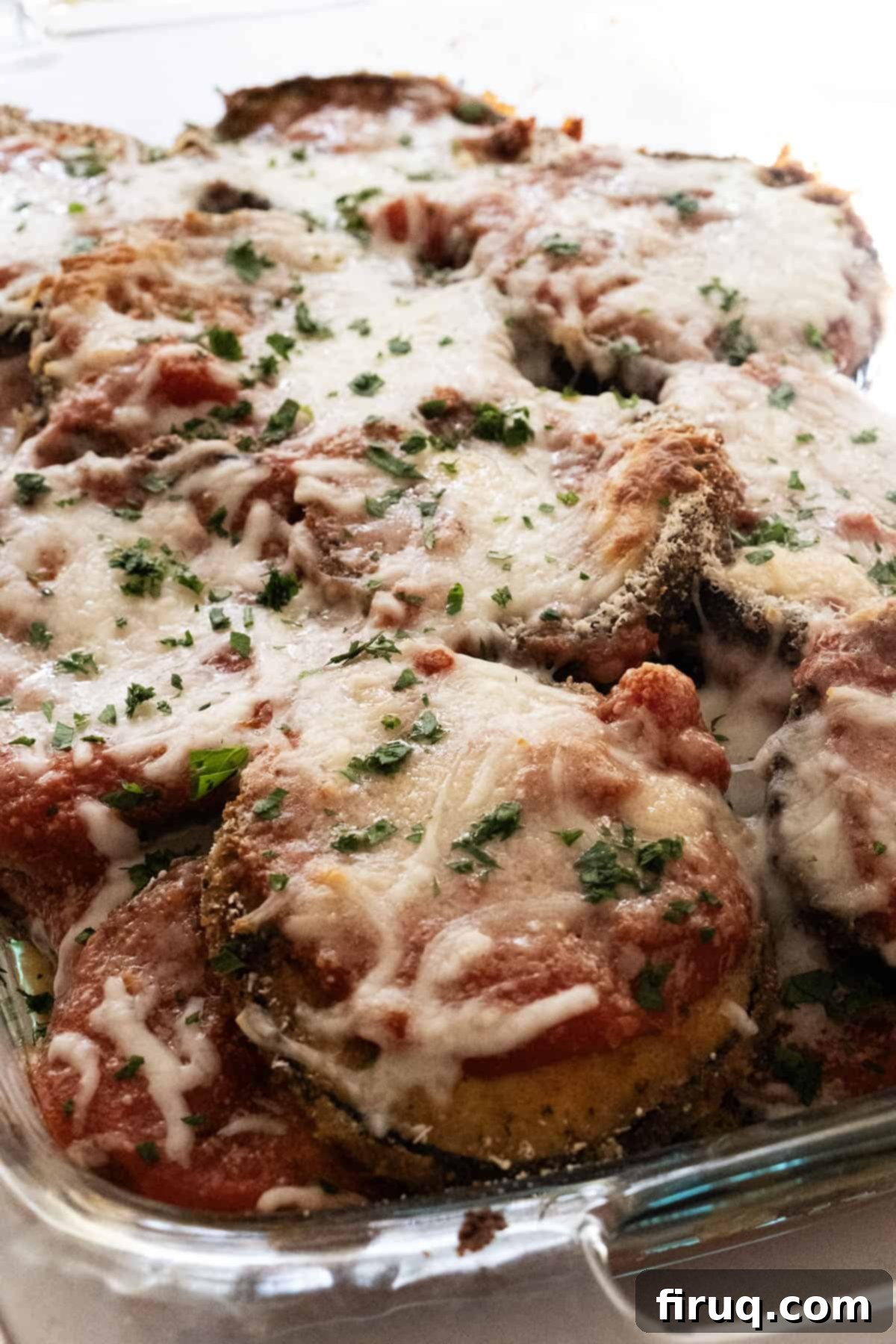
Pro-Tips for Your Best Eggplant Parmigiana
Elevate your homemade Eggplant Parmigiana from great to extraordinary with these expert tips:
- You will notice that the olive oil in your frying pan will deplete as you fry more batches of eggplant. It’s essential to keep adding more olive oil to the frying pan as you go to maintain a consistent frying depth and temperature. Additionally, as the breadcrumbs cook, some pieces may detach and burn. You will need to wipe the pan clean occasionally to remove some of these burnt breadcrumbs. This prevents them from sticking to subsequent batches and imparting a bitter taste. You don’t necessarily have to do this after every single batch, but aim for 1-2 times during the entire frying process, depending on the quantity of eggplant you’re preparing and how quickly the oil gets cloudy. A clean pan ensures clean flavors.
- Don’t bother with the tedious task of cutting the skin off the eggplant. It truly is a waste of time and perfectly good food. As mentioned earlier, modern eggplants are bred to be less bitter, and the skin is tender enough that after being twice-cooked (fried and then baked), it will become incredibly soft. You won’t even notice it’s there in the finished dish, and you’ll save valuable prep time. Trust me on this one; give it a try!
- Achieve Crispy Eggplant: Beyond salting, ensure your oil is hot enough (around 350-375°F or 175-190°C) and don’t overcrowd the pan. Fry in small batches to maintain oil temperature and allow even browning.
- Prevent Soggy Parmigiana: Besides salting the eggplant, a crucial tip is to let the fried eggplant drain thoroughly on a cooling rack or paper towels. Excessive oil can make the final dish greasy and heavy. Also, avoid overloading your baking dish with too much sauce, as this can make the bottom layers soggy. Balance is key.
- Rest Before Serving: After baking, let your Eggplant Parmigiana rest for at least 10-15 minutes before slicing and serving. This allows the layers to set, the cheese to firm up slightly, and the flavors to fully meld, resulting in cleaner cuts and a more enjoyable texture.
Common Questions About Eggplant Parmigiana
For many Italian food enthusiasts, Eggplant Parmigiana is undeniably superior, and it’s not even a close contest! While chicken parm is delicious, the delicate texture of perfectly fried eggplant, combined with the rich sauce and melted cheeses, creates a dish that feels a little bit lighter yet tastes incredibly rich and satisfying. Its unique earthiness and ability to absorb the flavors around it often lead people to find it more complex and appealing than its chicken counterpart. You might just find yourself eating the whole tray!
Eggplant Parmigiana is a beloved Italian layered casserole primarily composed of thinly sliced eggplant, which is typically breaded and fried until golden. These crispy eggplant slices are then layered with a vibrant tomato sauce (often a marinara or a simple homemade sauce), rich Parmesan cheese, and creamy mozzarella cheese. The entire assembly is then baked in the oven until the cheese is bubbly and melted, and the flavors have thoroughly melded together to create a harmonious and comforting dish.
Absolutely! Eggplant Parmigiana is an excellent dish for making ahead. You can assemble the entire dish, up to the point of baking, cover it tightly, and refrigerate it for up to 2-3 days. For longer storage, it freezes beautifully. Freezing it unbaked is often preferred as it prevents the eggplant from becoming too soft upon reheating. Just thaw in the refrigerator overnight before baking as usual.
For Eggplant Parmigiana, large globe eggplants (the most common variety found in supermarkets) work very well. Look for firm, shiny eggplants that feel heavy for their size. Smaller, slender Italian or Japanese eggplants can also be used, offering a slightly milder flavor and fewer seeds, though they might require more slices to fill your baking dish. The key is to choose fresh, firm eggplants regardless of the variety.
Storing and Reheating Your Eggplant Parmigiana
One of the many wonderful qualities of Eggplant Parmesan is how beautifully it stores and reheats. It’s often even better the next day as the flavors have more time to deepen and meld.
Storage Solutions
When preparing this dish for special occasions or holidays, I often assemble it in an aluminum tray. This makes for incredibly easy cleanup and convenience, especially when feeding a large gathering. Create the dish by layering the eggplant, sauce, and cheese just as you would in a Pyrex dish, then cover it securely with aluminum foil.
If you’re planning to enjoy your Eggplant Parmigiana on a later day, that’s perfectly fine. Assemble the tray of eggplant parm but do not bake it yet. Covering it tightly and placing it in the fridge will keep it fresh for up to 2-3 days. For longer storage, it can be placed in the freezer. My mom frequently used to freeze large trays of this delicious dish for us, sending them back to college as the ultimate care package. When freezing, ensure it’s wrapped very well to prevent freezer burn – ideally, a layer of plastic wrap directly on the food, then tightly sealed with aluminum foil. It can be stored in the freezer for up to 3 months.
After it has been baked, store any leftovers in an airtight container in the refrigerator and aim to eat it within 3-4 days.
Reheating for Optimal Flavor
Reheating Eggplant Parmigiana correctly ensures it retains its delicious texture and flavor profile. Don’t let those precious leftovers go to waste!
If reheating from the refrigerator, the best method is to throw it right back in the oven. For a full tray or a larger portion, bake at 350℉ (175°C) for approximately 45-60 minutes, or until heated through and bubbling. Alternatively, you can let it sit out on the counter for about an hour prior to heating, then bake for a shorter period, around 30-40 minutes. I always like to take the temperature of the center with a meat thermometer to ensure it’s thoroughly warmed and reaches above 145 degrees Fahrenheit (63°C) for food safety and optimal enjoyment.
If reheating from frozen, it’s best to defrost it in the refrigerator for 24 hours ahead of time. Once thawed, follow the above instructions for reheating from the refrigerator. Avoid microwaving large portions, as it can lead to uneven heating and a rubbery texture, though a single slice can be quickly warmed that way if necessary.
There is truly nothing like eggplant parm leftovers, especially the day after! Go ahead and make yourself an Eggplant Parm Sandwich – it’s a game-changer!
What to Serve with Your Homemade Eggplant Parmigiana
Eggplant Parmigiana is a show-stopping dish on its own, but it truly shines when accompanied by complementary sides and other Italian classics. Whenever I serve this to guests, I’m usually feeding a crowd, so I love to offer a variety of delicious options!
For a truly grand Italian feast, I love to serve it alongside other hearty main courses such as the bright and lemony Chicken Francese, the rich and savory Chicken Marsala, classic Italian Sausage and Peppers, or crispy Italian Chicken Cutlets. These dishes offer a wonderful contrast in textures and flavors, ensuring there’s something for everyone.
Of course, a robust Italian meal always calls for pasta! I always need to have a pasta dish on the side. Consider a simple rigatoni tossed with my comforting Sunday Sauce or a creamy Creamy Red Pepper Sauce. For something easy yet delightful, try a flavorful Italian Pink Sauce with Sausage or traditional Busiate with Pesto Trapanese.
If you’re looking for lighter, yet equally flavorful side dishes to serve alongside your Eggplant Parmigiana, you absolutely have to add these to your menu: a rustic Italian Cabbage Recipe, a vibrant Italian Lacinato Kale Recipe (Tuscan), and savory Baked Italian Stuffed Portobello Mushrooms. These vegetable-forward options provide a fresh balance to the richness of the parmigiana. Or, for a warm and comforting start, try serving it with a classic soup like Classic Pasta Fagioli.
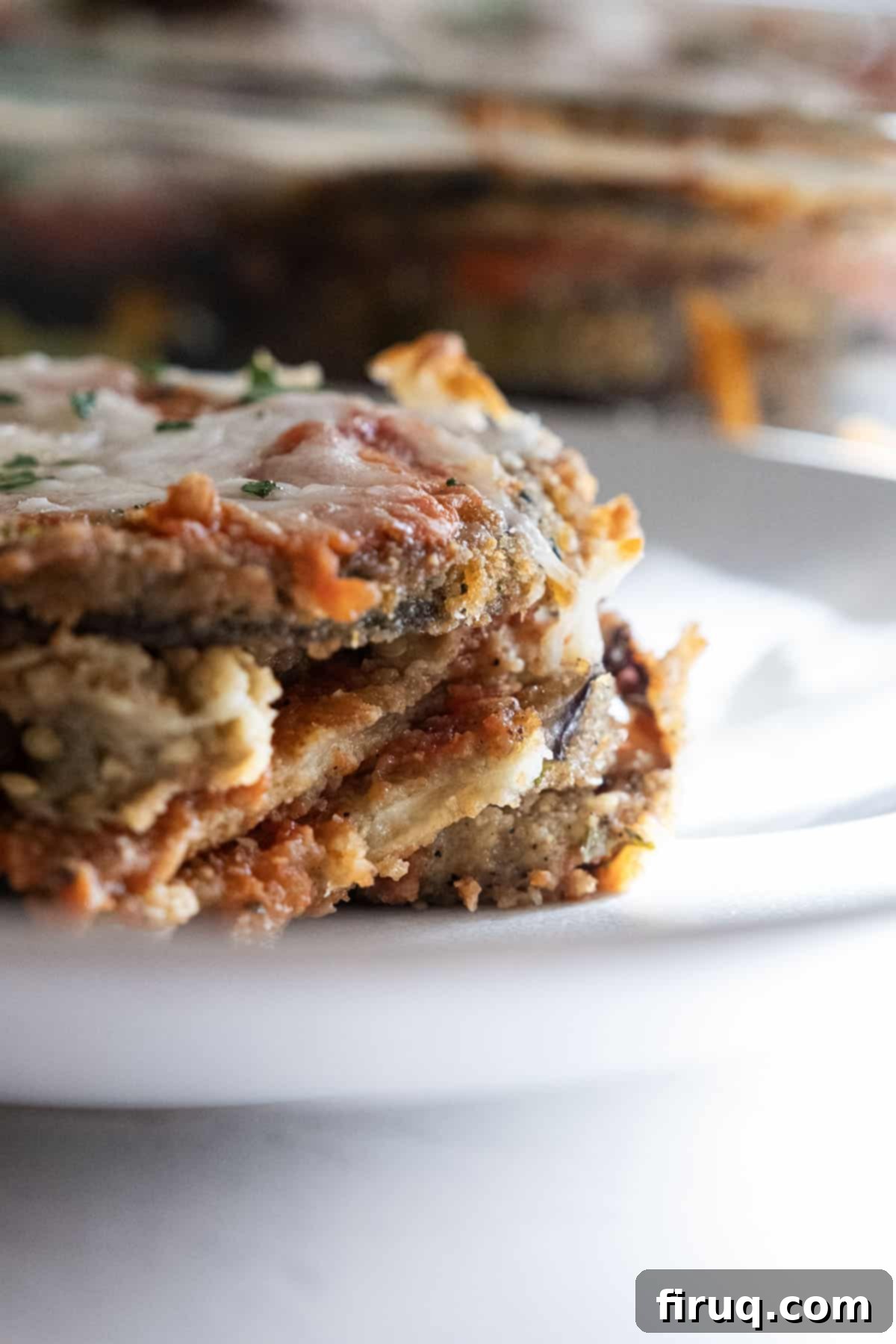
Watch the Recipe: Eggplant Parmigiana in Action!
Visual learners, rejoice! Sometimes, seeing a recipe come to life makes all the difference. Check out our quick video below to see each step of this delicious Eggplant Parmigiana recipe, from prepping the eggplant to layering it perfectly in the baking dish. It’s the perfect companion to the written instructions, ensuring you master this classic with confidence.
Explore More Authentic Italian Classics
If you’ve enjoyed mastering this Eggplant Parmigiana, then you’re sure to love diving into more of our authentic Italian recipes. These dishes are perfect for expanding your culinary repertoire and bringing the rich flavors of Italy right into your kitchen.
- Italian Stuffed Peppers in Tomato Sauce
- Italian Sausage and Peppers
- Restaurant-Style Chicken Francese
- Restaurant-Style Chicken Marsala
We absolutely love hearing from you! Please leave a comment and a star rating below in the recipe card to let us know what you think of our recipes. Your feedback helps us grow and inspires us to create more delicious content. Feel free to tag us on Instagram @vindelgiudice when you share your creations!
📖 Recipe
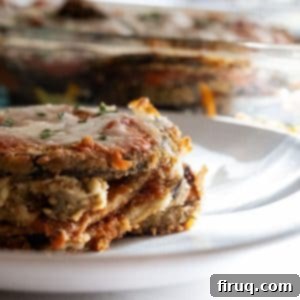
Better than Olive Garden Eggplant Parmigiana
Vincent DelGiudice
Pin Recipe
Equipment
-
1 large frying pan
-
1 9×13 baking dish
-
1 medium pot
Ingredients
- 2 eggplants (medium-sized globe eggplants, about 1.5-2 lbs each)
- 2 cups plain breadcrumbs (Panko also works for extra crispiness)
- 3 tablespoon fresh parsley, chopped
- 2 tablespoon garlic powder
- 2 teaspoon kosher salt (for seasoning breadcrumbs and salting eggplant)
- ¼ cup grated parmesan cheese (for breadcrumb mixture)
- olive oil (for frying, approximately ½ inch depth in pan)
- 3 large eggs (whisked for dredging)
For the Rich Tomato Sauce
- 1 28 oz can high-quality crushed tomatoes
- 6 fresh basil leaves
- 1 teaspoon salt (or to taste)
- 2 cloves garlic, minced
- 1 tablespoon olive oil (for sauce)
For Layering & Toppings
- 1 cup grated parmesan cheese (for layering)
- ½ cup shredded mozzarella cheese (for topping)
Instructions
-
To make the sauce: Place a medium pot on your stovetop on medium heat. Add 1 tablespoon of olive oil. Add the minced garlic to the pan and sauté for 1-2 minutes or until it becomes fragrant and slightly golden. Pour in the 28 oz can of crushed tomatoes and bring them to a gentle simmer. Add the 6 fresh basil leaves and 1 teaspoon of salt, stirring well. Allow the sauce to simmer gently for at least 30 minutes, uncovered, to develop its flavors. Stir occasionally to prevent sticking.
-
Prepare the eggplant: Slice the eggplants into uniform ¼-inch circular slices. There is no need to remove the skin. Lay the eggplant slices on a cooling rack or flat surface, sprinkle both sides generously with kosher salt, and let them sit for 20-30 minutes to draw out moisture. While the eggplant salts, whisk the 3 large eggs in a shallow bowl. On a separate plate or shallow dish, combine the 2 cups of breadcrumbs, 2 teaspoons of kosher salt, 2 tablespoons of garlic powder, 3 tablespoons of fresh chopped parsley, and ¼ cup of grated parmesan cheese, mixing well. Pat the eggplant slices completely dry with paper towels to remove moisture and excess salt. Dip each eggplant slice into the whisked egg, letting excess drip off, then dredge it thoroughly in the seasoned breadcrumb mixture, pressing gently to ensure an even coating. Set the coated eggplant slices on a clean plate or baking sheet and continue until all slices are breaded.
-
Fry the eggplant: Add about ½ an inch of olive oil to a large frying pan on the stovetop on medium-high heat. Once the olive oil is hot and shimmering (around 350-375°F / 175-190°C), carefully place your breaded eggplant slices into the oil in batches, ensuring not to overcrowd the pan. You may need to lower the heat slightly if the oil starts to splatter excessively. Fry each side of the eggplant for approximately 2 minutes, or until golden brown and crispy. Flip once to ensure even cooking. Remove the fried eggplant and set it on a cooling rack lined with paper towels to drain excess oil. While still warm, sprinkle lightly with a small amount of kosher salt. You will need to add more olive oil to the pan as you go, and occasionally wipe the pan clean to remove any burnt breadcrumbs, preventing them from affecting subsequent batches.
-
Assemble the Parmigiana: Preheat your oven to 375℉ (190°C). Line the bottom of a 9×13 inch baking pan with a couple of spoonfuls of your prepared tomato sauce. Arrange a single layer of fried eggplant slices over the sauce. Top this eggplant layer with more sauce, spreading it evenly. Generously sprinkle 1 cup of grated parmesan cheese over the sauce. Add another layer of fried eggplant, followed by more sauce and parmesan. Continue this layering process until you’ve used all the eggplant and reached the top of your pan, ending with a layer of sauce and parmesan. Finally, add the ½ cup of shredded mozzarella cheese evenly over the very top layer.
-
Bake and serve: Place the assembled pan in the preheated oven and bake for 20-25 minutes, or until the mozzarella cheese is melted, bubbly, and lightly golden brown. Remove from the oven and let it rest for 5-10 minutes before serving. This resting period allows the layers to set, making it easier to slice and serve neatly. Enjoy your delicious homemade Eggplant Parmigiana!
Notes
- You will have to keep adding more olive oil to the frying pan as you go to maintain an adequate depth for frying. It is also highly recommended to wipe the pan clean occasionally to remove some of the burnt breadcrumbs that accumulate. This isn’t necessary after every single batch, but doing it maybe 1-2 times during the entire frying process, especially if you notice dark bits, will prevent them from making your subsequent eggplant batches taste bitter.
- While I love making my own sauce from scratch for the freshest flavor, you can certainly use any high-quality store-bought marinara sauce you have or prefer. Just make sure it’s a brand you enjoy, as the sauce is a critical component of the dish’s overall taste.
- For an extra layer of flavor and aroma, consider adding a pinch of dried oregano or Italian seasoning to your breadcrumb mixture. This subtle addition can enhance the traditional Italian profile.
- If you prefer a softer, less crispy eggplant, you can skip the breading and simply pan-fry or bake the salted eggplant slices directly. This yields a slightly different texture but is still delicious.
Nutrition
